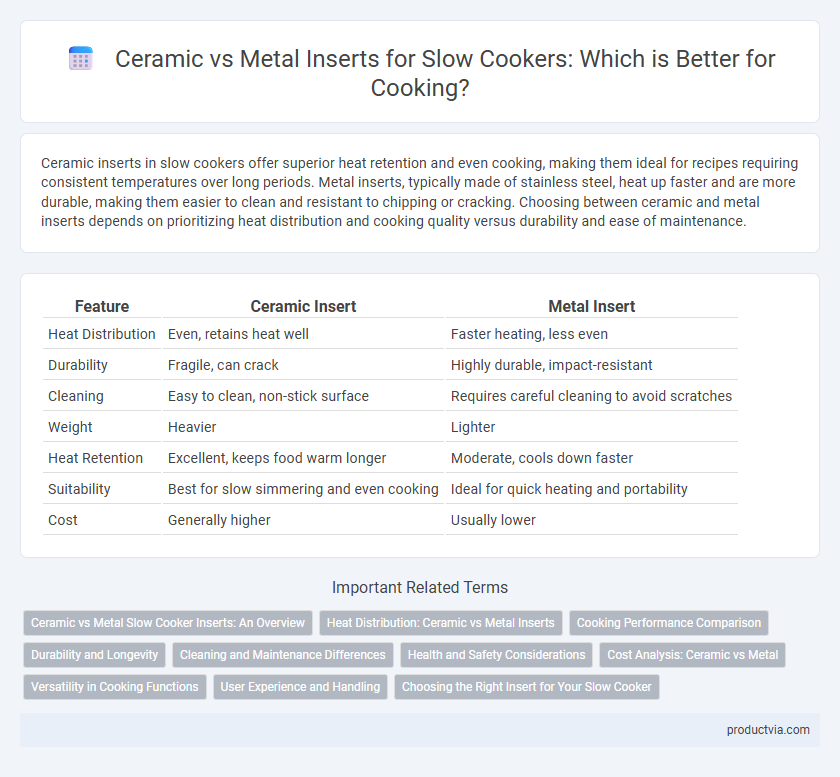Ceramic inserts in slow cookers offer superior heat retention and even cooking, making them ideal for recipes requiring consistent temperatures over long periods. Metal inserts, typically made of stainless steel, heat up faster and are more durable, making them easier to clean and resistant to chipping or cracking. Choosing between ceramic and metal inserts depends on prioritizing heat distribution and cooking quality versus durability and ease of maintenance.
Table of Comparison
| Feature | Ceramic Insert | Metal Insert |
|---|---|---|
| Heat Distribution | Even, retains heat well | Faster heating, less even |
| Durability | Fragile, can crack | Highly durable, impact-resistant |
| Cleaning | Easy to clean, non-stick surface | Requires careful cleaning to avoid scratches |
| Weight | Heavier | Lighter |
| Heat Retention | Excellent, keeps food warm longer | Moderate, cools down faster |
| Suitability | Best for slow simmering and even cooking | Ideal for quick heating and portability |
| Cost | Generally higher | Usually lower |
Ceramic vs Metal Slow Cooker Inserts: An Overview
Ceramic slow cooker inserts offer superior heat retention and even cooking, making them ideal for recipes requiring consistent, gentle heat. Metal inserts, typically stainless steel or aluminum, provide faster heating and greater durability, suitable for high-temperature cooking and easy metal utensil use. Choosing between ceramic and metal slow cooker inserts depends on your cooking style, maintenance preference, and the specific dishes you prepare.
Heat Distribution: Ceramic vs Metal Inserts
Ceramic inserts in slow cookers offer even heat distribution and excellent heat retention, resulting in consistent cooking temperatures ideal for delicate dishes. Metal inserts, typically stainless steel, heat up faster and respond quickly to temperature changes but may create hot spots if not properly monitored. Choosing between ceramic and metal inserts depends on whether slow, consistent heat or rapid temperature adjustments are prioritized during cooking.
Cooking Performance Comparison
Ceramic inserts in slow cookers offer superior heat retention and even cooking, maintaining consistent temperatures ideal for slow, low-temperature recipes. Metal inserts, often made of stainless steel or aluminum, heat up more quickly but may have hotspots that affect uniform cooking, making them better suited for short-duration or high-heat tasks. Ceramic's non-reactive surface also enhances flavor preservation, while metal inserts provide durability and easier cleaning.
Durability and Longevity
Ceramic inserts for slow cookers offer excellent heat retention and even cooking but are more prone to chipping and cracking, affecting long-term durability. Metal inserts, typically stainless steel, provide superior resistance to physical damage and corrosion, ensuring longer lifespan under frequent use. Choosing metal inserts enhances slow cooker longevity due to their robust construction and ability to withstand daily wear and tear.
Cleaning and Maintenance Differences
Ceramic inserts for slow cookers are generally easier to clean due to their non-porous surface, resisting food stains and odors more effectively than metal. Metal inserts, often made from stainless steel, require thorough drying to prevent rust and may need scrubbing for baked-on residue. Ceramic is dishwasher safe and maintains its smooth texture over time, while metal demands regular maintenance to avoid corrosion and maintain its finish.
Health and Safety Considerations
Ceramic slow cooker inserts are non-reactive and provide even heat distribution, reducing the risk of harmful chemical leaching and ensuring safer food preparation. Metal inserts, typically made of stainless steel or aluminum, heat faster but can sometimes react with acidic foods, potentially affecting taste and safety. Choosing ceramic inserts minimizes exposure to toxins and is preferred for slow cooking longer, while metal inserts offer durability but require careful use with acidic ingredients.
Cost Analysis: Ceramic vs Metal
Ceramic inserts for slow cookers generally have a higher upfront cost compared to metal inserts, but they offer better heat retention and even cooking, which can reduce energy usage over time. Metal inserts are more affordable and typically lighter, making them easier to handle and clean, but they may heat unevenly and require more careful monitoring during cooking. Considering long-term durability, ceramic inserts tend to be more prone to cracking, while metal inserts can withstand more rigorous use, impacting overall replacement costs.
Versatility in Cooking Functions
Ceramic inserts in slow cookers retain heat evenly, making them ideal for recipes that require steady, gentle cooking like stews and casseroles, while metal inserts heat up faster and are more durable for searing or browning before slow cooking. Metal inserts are often preferred for tasks that involve transferring between stovetop and slow cooker, providing versatility for multi-step cooking processes. Ceramic inserts offer excellent heat distribution but are generally less adaptable for varied cooking functions compared to the robust and heat-conductive metal alternatives.
User Experience and Handling
Ceramic inserts in slow cookers provide even heat distribution and retain warmth longer, enhancing the cooking experience by preventing hot spots and ensuring thorough cooking. Metal inserts, often made of stainless steel or aluminum, heat up faster and are more durable, making them easier to handle for frequent use and ideal for high-heat recipes. Ceramic is heavier and requires careful handling to avoid chipping, whereas metal inserts offer lightweight convenience and greater resistance to wear and tear, improving user ease during cleaning and storage.
Choosing the Right Insert for Your Slow Cooker
Ceramic inserts for slow cookers offer superior heat retention and even cooking, making them ideal for soups and stews that benefit from consistent low temperatures. Metal inserts, often made from stainless steel, provide faster heating and durability, suitable for browning ingredients directly in the insert before slow cooking. Selecting the right insert depends on your cooking style and maintenance preferences, with ceramic favored for gentle, steady heat and metal preferred for versatility and ease of cleaning.
Ceramic vs Metal Insert for Slow Cooker Infographic

 productvia.com
productvia.com